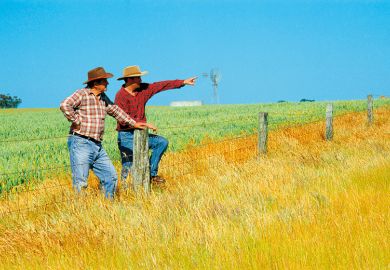Australia’s freezing of teaching funding has put an end to a growth spurt in higher education in rural areas, universities have warned.
Newly compiled figures suggest that the country’s demand-driven admissions system had been living up to its promise of generating opportunities in the bush, with the number of students being taught in regional areas rising by 12 per cent in the scheme’s first five years.
However, this was less than the 20 per cent growth in metropolitan delivery. And in an ironic twist, the effective recapping of student numbers that is the consequence of a two-year funding freeze announced in December is expected to hit the regions harder than the cities.
The new figures were assembled from unpublished institutional data by the Innovative Research Universities group, which has seven members across Australia. Unlike public statistics, which detail the proportion of students who come from regional areas, the new data reveal the share of higher education delivery that takes place outside major cities.
IRU said that regional delivery was crucial because appetite for higher education was lower there than it was in the cities.
“Having a university outside the major metropolitan areas adds variety to the regions, drawing in people and setting the base for more diverse economies,” said IRU executive director Conor King. “That growth is now set to stop, not because there are not people wanting university places but because universities will not be able to teach them.”
Regional universities have warned that the funding freeze will affect them disproportionately because they are more dependent on government funding than city-based institutions. Analysis by the Australian Broadcasting Corporation found that the freeze would cost universities with substantial regional campuses an average of 6 per cent of their base funding by 2021, compared with 4 per cent for institutions specialising in urban delivery.
The IRU data show that member institutions were responsible for 17 per cent of regional higher education delivery in 2016, the latest year for which figures are available. They taught some 54,000 students in the bush, about 6,000 more than in 2011.
Overall regional delivery had increased by about 33,000 places, including an extra 14,000 at the Regional Universities Network and 17,000 at unaffiliated universities. Non-metropolitan teaching by other groups had fallen by about 5,000 places, primarily because of the transfer of two city-based universities’ regional campuses.
Mr King said that the data showed that the government needed to reconsider its funding freeze. “Once it feels the heat from the generation now coming through school, we will need a flood of places from the early 2020s,” he said.
He said that the lower tertiary participation rates in regional areas suggested that there was substantial unmet demand there. Regional universities anticipated ongoing enrolment growth, unlike many city-based institutions.
Register to continue
Why register?
- Registration is free and only takes a moment
- Once registered, you can read 3 articles a month
- Sign up for our newsletter
Subscribe
Or subscribe for unlimited access to:
- Unlimited access to news, views, insights & reviews
- Digital editions
- Digital access to THE’s university and college rankings analysis
Already registered or a current subscriber?








